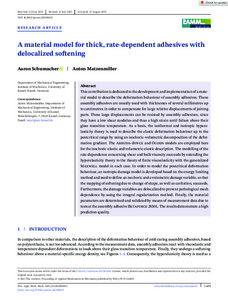| dc.date.accessioned | 2024-03-08T12:36:42Z | |
| dc.date.available | 2024-03-08T12:36:42Z | |
| dc.date.issued | 2023-10-04 | |
| dc.identifier | doi:10.17170/kobra-202403089744 | |
| dc.identifier.uri | http://hdl.handle.net/123456789/15543 | |
| dc.description.sponsorship | Gefördert im Rahmen des Projekts DEAL | |
| dc.language.iso | eng | |
| dc.rights | Namensnennung 4.0 International | * |
| dc.rights.uri | http://creativecommons.org/licenses/by/4.0/ | * |
| dc.subject.ddc | 510 | |
| dc.subject.ddc | 620 | |
| dc.title | A material model for thick, rate-dependent adhesives with delocalized softening | eng |
| dc.type | Aufsatz | |
| dcterms.abstract | This contribution is dedicated to the development and implementation of a material model to describe the deformation behaviour of assembly adhesives. These assembly adhesives are usually used with thicknesses of several millimetres up to centimetres in order to compensate for large relative displacements of joining parts. These large displacements can be resisted by assembly adhesives, since they have a low shear modulus and thus a high strain until failur above their glass transition temperature. As a basis, the isothermal and isotropic hyperelasticity theory is used to describe the elastic deformation behaviour up to the postcritical range by using an isochoric–volumetric decomposition of the deformation gradient. The Arruda–Boyce and Ogden models are employed here for the isochoric-elastic and volumetric-elastic description. Themodelling of the rate-dependence concerning shear and bulk viscosity succeeds by extending the hyperelasticity theory to the theory of finite viscoelasticity with the generalized Maxwell model in each case. In order to model the postcritical deformation behaviour, an isotropic damage model is developed based on the energy limiting method and used to define an isochoric and a volumetric damage variable, so that the mapping of softening due to change of shape, as well as cavitation, succeeds. Furthermore, the damage variables are delocalized to prevent pathologicalmesh dependence by using the integral regularization method. Finally, the material parameters are determined and validated by means of measurement data due to tests at the assembly adhesive Betaforce 2850L. The results demonstrate a high prediction quality. | eng |
| dcterms.accessRights | open access | |
| dcterms.creator | Schumacher, Aaron | |
| dcterms.creator | Matzenmiller, Anton | |
| dc.relation.doi | doi:10.1002/pamm.202300032 | |
| dc.subject.swd | Empfehlung | ger |
| dc.subject.swd | Implementation | ger |
| dc.subject.swd | Stoffgesetz | ger |
| dc.subject.swd | Deformationsverhalten | ger |
| dc.subject.swd | Klebstoff | ger |
| dc.type.version | publishedVersion | |
| dcterms.source.identifier | eissn:1617-7061 | |
| dcterms.source.issue | Issue 3 | |
| dcterms.source.journal | Proceedings in Applied Mathematics & Mechanics | eng |
| dcterms.source.volume | Volume 23 | |
| kup.iskup | false | |
| dcterms.source.articlenumber | e202300032 | |


